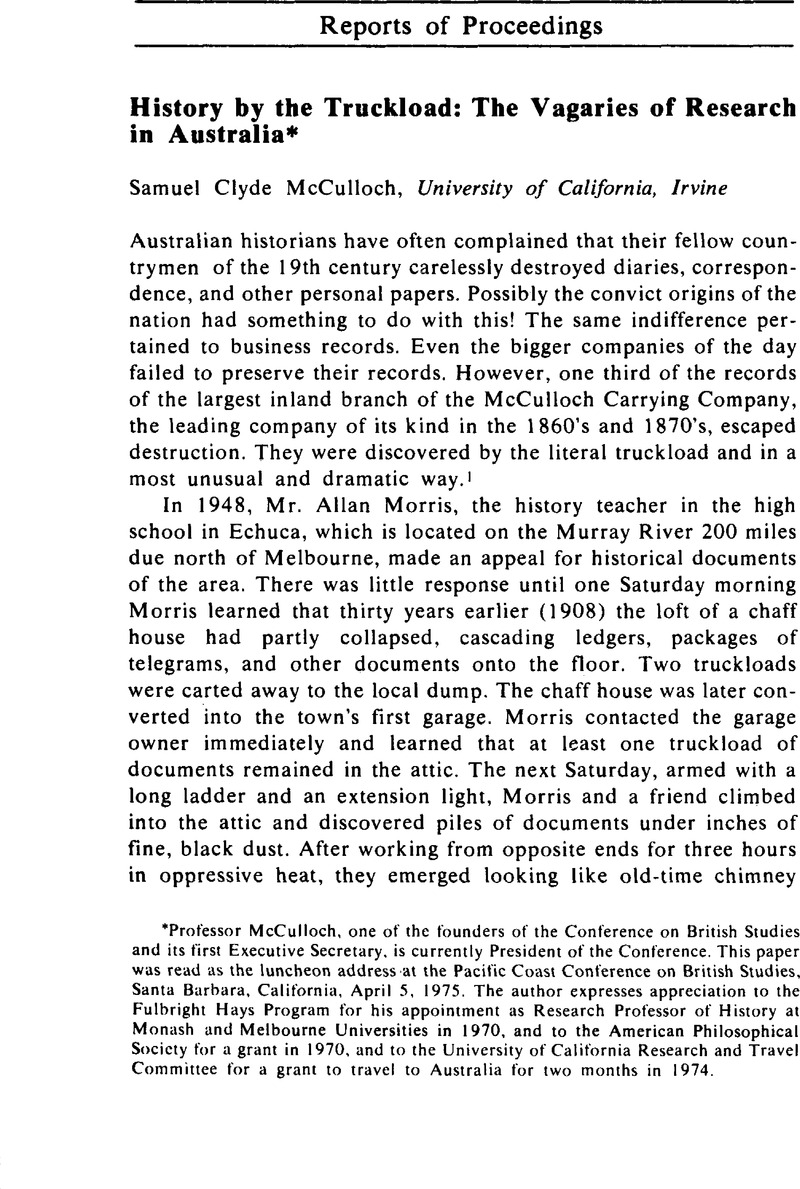No CrossRef data available.
Article contents
Reports of Proceedings
Published online by Cambridge University Press: 11 July 2014
Abstract

- Type
- Meeting Report
- Information
- Copyright
- Copyright © North American Conference on British Studies 1975
References
* Professor McCulloch, one of the founders of the Conference on British Studies and its first Executive Secretary, is currently President of the Conference. This paper was read as the luncheon address at the Pacific Coast Conference on British Studies, Santa Barbara, California, April 5, 1975. The author expresses appreciation to the Fulbright Hays Program for his appointment as Research Professor of History at Monash and Melbourne Universities in 1970, and to the American Philosophical Society for a grant in 1970, and to the University of California Research and Travel Committee for a grant to travel to Australia for two months in 1974.
1 “History by the Truckload” comes from the title ot a talk given over the Australian Broadcasting Commission on August 15, 1954 by Allan Morris. A typescript is appended to the 144 folio page “Catalogue of the Records, 1866-1883 of the Echuca Branch of the Wm. McCulloch and Co. Ltd.” Morris later incorporated this and other material into three articles: “The Big Rivers,” Overland, No. 4 (June, 1955), pp. 22–3Google ScholarPubMed, “The Big Rivers—II,” ibid. No. 5 (October, 1955), pp. 34-6, and “The Big Rivers—III,” ibid. No. 8 (November, 1956), pp. 31-2. In 1952, Allan, Morris published his book Rich River (Echuca, 1952)Google Scholar in which he tells the story of the Murray River and its tributaries and the river boat trade. A second edition has been published in 1970 by the Colac Herald.
2 Professor of History at the University of Melbourne, 1937-1970.
3 At the time teaching at the University of Melbourne, then Professor of History at the Australian National University from 1949 to the present.
4 For an excellent account of the history of Echuca see Priestley, Susan, Echuca, A Centenary History (Brisbane, 1965).Google Scholar
5 Allan Morris was the first to write with authority on the river boat trade in Rich River. Since then there have been other books, the more important of which are Mudie, Ian, Riverboats (Melbourne, 1965)Google Scholar and Phillips, Peter, River Boat Days on the Murray, Darling, Murrumbidgee (Melbourne, 1974).Google Scholar
6 This catalogue, cited in footnote 1, was typed in 1949 and is now located in the La Trobe Library, the manuscript, rare book, and archival wing of the Public Library of Victoria, Melbourne.
7 Professor of History, 1948 to the present.
8 History by the Truckload MS, p. 2.
9 These and other examples come from the McCulloch Carrying Co. Papers MSS (hereafter cited as MCP MSS) which I have examined in the La Trobe Library. This episode is repeated by Morris in History by the Truckload MS, pp. 3-4.
10 Ibid., p. 4.
11 MCP MSS, Masters' Journals, Box 46.
12 “History by the Half-Ton,” The Sun, 11 November, 1950.Google ScholarPubMed
13 Morris, , “The Big Rivers—II,” p. 35.Google Scholar
14 Ibid., p. 36.
15 MCP MSS, In Telegrams, Box 35.
16 “Catalogue of the Records,…” Introduction.
17 MCP MSS, Weather Reports, Box 87.
18 Ibid., River Charts, 2 packets.
19 Phillips, pp. 54-5.
20 He bought “Mertoun Park,” a property of about 1340 acres in 1884. Since the mid I870's he had owned “Glenroy” near Melbourne for breeding mostly cattle. The Colac Herald wrote on 10 Nov., 1885: “On Saturday last the Hon. Wm. McCulloch, of Mertoun Park, disposed of his magnificant property in Melbourne, known as Glenroy…In consequence of the sale of his property (700 acres) the whole of Mr. McCulloch's famous studs of shorthorn cattle and Clydesdale horses will be removed to his estate near colac.” The property in New South Wales was purchased in 1886 and was 63,000 acres. Its name was and is “Warbreccan” near Deniliquin.
21 “Woodlands,” near Ararat was nearly 56,000 acres and “one of the most imposing country homes in Victoria” built in 1869 by John Wilson. McCulloch made this his country home. Here he retired in 1903, and here he died in 1909.
22 See my article “William McCulloch as Minister of Defence for Victoria, 1895-1901” which will appear in early 1976 in The Victorian Historical Journal.
23 See also Ellis, M. H., The Beef Shorthorn in Australia (Sydney, 1923).Google Scholar
24 See the author's article on McCulloch, William in the Australian Dictionary of Biography. Edited by Pike, Douglas (Melbourne, 1974), Vol 5, pp. 143–4Google Scholar. See also the author's article on James McCulloch in ibid., pp. 142-3. The McCulloch Carrying Co. Papers provide considerable source material for my forthcoming book “Prince of Spenders: The Life and Times of William McCulloch, 1832-1909.”


